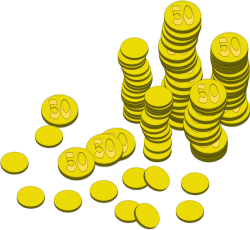Pricing Should Be Simple article mentions some interesting points on pricing products:
One thing many companies — in any industry — can learn from Apple is the importance of simple pricing. If you make it easy for people to understand how much they’re paying, and what they’re paying for, it is more likely that they’ll buy it.
The decision to purchase and the act of paying are part of the experience for any product or service, and should be designed accordingly.
Not paying is always simple.
Those companies that succeed with complex pricing schemes tend to be those with no competition (e.g. cable companies and land-line phone services) or those with a limited number of competitors, all of whom offer similarly complex pricing schemes
For non-necessities, simplicity of pricing is key.
Simple pricing (besides cheap prices) is one thing I really in dealextreme web shop. You just pay the price shown on the screen and no extra. In many other web shops you can see the product price, but you have to quess what might be be the final price you pay when you add the shipping costs (getting to know them even approximately takes quite many steps in too many web shops). This is a thing which could be improved in many web shops.

5 Comments
Corine Rippin says:
I believe that avoiding highly processed foods could be the first step to help lose weight. They will taste beneficial, but highly processed foods have very little nutritional value, making you consume more in order to have enough vigor to get over the day. In case you are constantly ingesting these foods, switching to whole grain products and other complex carbohydrates will let you have more vigor while eating less. Good blog post.
See this link says:
Magnificent beat ! I wish to apprentice while you amend your web site, how could i subscribe for a weblog site? The account aided me a appropriate deal. I had been a little bit familiar of this your broadcast offered bright transparent idea
Tomi Engdahl says:
The customer wants what the customer wants
http://www.edn.com/electronics-blogs/other/4391692/The-customer-wants-what-the-customer-wants
US drivers, for the most part, have a love affair with their cars – bigger is better. What sells successfully in one part of the world could be, for one reason or another, an abysmal failure in another. And organizations engaged in any market must develop different ways of imagining the market and create different product strategies to exploit these segments.
The product strategy a company develops to go after a particular market segment can give that company a temporary commercial advantage. Nobody does this better than the auto industry.
What is market segmentation?
Market segmentation is a marketing strategy for dividing large target markets into subsets based on consumer needs for applications, goods and services. These subsets may be divided by specific product characteristics, such as power consumption or performance. This information forms the basis for the marketing campaigns that are designed and implemented with specific customers in mind.
Now that you’ve segmented your market, you need to realize that the customers may see themselves differently and they will segment themselves. And that self-selected segmentation will determine how and why a given customer selects between competing products and services.
Therefore, companies must ensure that their offering meets those customer-defined needs better than any other market entry if the goal is winning market share. The best technology doesn’t always win the sale
Tomi Engdahl says:
A Rake Too Far: Optimal Platform Pricing Strategy
http://abovethecrowd.com/2013/04/18/a-rake-too-far-optimal-platformpricing-strategy/
In a casino, the term “rake” refers to the commission that the house earns for operating a poker game. With each hand, a small percentage of the pot is scraped off by the dealer, which in essence becomes the “revenue” for the casino.
Many Internet marketplaces also have a rake or vig. The percentage rake is the amount that the marketplace charges as a percentage of GMS (gross merchandise sales), which typically represents net revenues for the marketplace.
You can see very high rakes in the case of iTunes, Facebook, and GroupOn down to especially low rakes
These reasons are likely behind the struggles in GroupOn’s core Daily Deals business (North America Third Party Revenue is down in Q4 both YOY and QOQ). With a rake of approximately 38% (and this is “after” asking the merchant to underwrite a 50% discount to the consumer) the recovery from each transaction for the supplier is only 30%, representing an “effective” rake of 70%.
High volume combined with a modest rake is the perfect formula for a true organic marketplace and a sustainable competitive advantage. A sustainable platform or marketplace is one where the value of being in the network clearly outshines the transactional costs charged for being in the network. This way, suppliers will feel obliged to stay on the platform, and consumers will not see prices that are overly burdened by the network provider. Everyone wins in this scenario, but particularly the platform provider.
A high rake will allow you to achieve larger revenues faster, but it will eventually represent a strategic red flag – a pricing umbrella that can be exploited by others in the ecosystem, perhaps by someone with a more disruptive business model.
As Jeff Bezos is fond of saying, “your margin is my opportunity.”
Tomi Engdahl says:
The realities of building an IPv6-only city
https://blog.apnic.net/2024/10/29/the-realities-of-building-an-ipv6-only-city/
As previously discussed in this post, Xiong’an New Area (Xiong’an), a pilot city established in 2017 about 100 kilometres west of Beijing, aims to be a model for future digital cities, built with IPv6-only infrastructure from the start. To achieve this, the local government is prioritizing IPv6 in its top-level planning, designing for the deployment of 198,000 sensors per square kilometre, and supporting over 1 million Internet of Things (IoT) devices per square kilometre. This post will look at the lessons the Xiong’an team has learned so far from building this IPv6-only city.